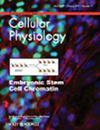The attachment of glycolytic enzymes to muscle ultrastructure
引用次数: 49
Abstract
The glycolytic enzymes, lactic dehydrogenase and aldolase, usually thought to be freely dissolved in the sarcoplasmic matrix, are in good part attached to the muscle ultrastructure. This attachment becomes manifest when the enzyme activities and specific activities of the press juices of whole skeletal muscles (rabbit) are compared with those of minced muscles, all obtained by ultracentrifugation of the tissues at 40,000 xpm for 16 to 20 hours. Mincing causes a great increase in the activities, associated with a rise in the volume and protein concentration of the press juices. We interpret these increases to be due to the solution in the matrix of enzymes previously attached to the ultrastructure. The same conclusion is reached by a different method, which we call “washing the ultrastructure.” It consists in multiple centrifugations of whole skeletal muscles, and removal of press juices, alternating with periods of imbibition of a buffer (0.1 M phosphate at pH 7.5) too dilute to dissolve out the fibrous proteins. During the imbibitions enzymes diffuse out into the buffer not imbibed, which becomes an extract. After four centrifugation-imbibition sequences in as many days nearly all of the fluid matrix has been replaced by buffer. Enzyme activities fall steeply in press juices and extracts until nearly all freely dissolved enzymes have been washed away. Homogenates of the pressed muscles then show activities which are about half of those found in the homogenates of unpressed control muscles. We conclude that the enzymes found in the homogenates of the pressed muscles have previously been attached to the ultrastructure. Similar experiments with heart muscle indicate that nearly all of these enzymes are normally attached to the ultrastructure. Press juices contain only traces of activity, even after the heart has been minced. A fraction of the enzymes is slowly detached during the centrifugation-imbibition sequences, appearing mainly in the extracts.糖酵解酶在肌肉超微结构上的附着
糖酵解酶、乳酸脱氢酶和醛缩酶,通常被认为是自由溶解在肌浆基质中的,大部分附着在肌肉的超微结构上。当将整个骨骼肌(兔)的压榨液与切碎的肌肉的压榨液的酶活性和比活性进行比较时,这种附着性就变得明显了,所有这些都是通过在40000 xpm的条件下对组织进行16至20小时的超离心得到的。切碎会使活性大大增加,与压榨汁的体积和蛋白质浓度的增加有关。我们将这些增加解释为由于先前附着在超微结构上的酶基质中的溶液。同样的结论可以通过另一种不同的方法得到,我们称之为“清洗超微结构”。它包括对整个骨骼肌进行多次离心,去除榨出的汁液,交替吸吸缓冲液(0.1 M磷酸盐,pH值为7.5),缓冲液太稀,无法溶解出纤维蛋白。在吸收过程中,酶扩散到缓冲液中,而缓冲液没有被吸收,就变成了提取物。在连续4次离心吸吸后,几乎所有的流体基质都被缓冲液所取代。在榨汁和提取物中,酶的活性急剧下降,直到几乎所有自由溶解的酶都被冲走。受压肌肉的匀浆体显示出的活动大约是未受压对照肌肉匀浆体的一半。我们得出结论,在挤压肌肉的匀浆中发现的酶先前已经附着在超微结构上。类似的心肌实验表明,几乎所有这些酶通常都附着在心肌的超微结构上。即使在心脏被切碎之后,榨出的汁液也只含有活动的痕迹。一部分酶在离心吸胀过程中缓慢分离,主要出现在提取物中。
本文章由计算机程序翻译,如有差异,请以英文原文为准。
求助全文
约1分钟内获得全文
求助全文

 求助内容:
求助内容: 应助结果提醒方式:
应助结果提醒方式:


